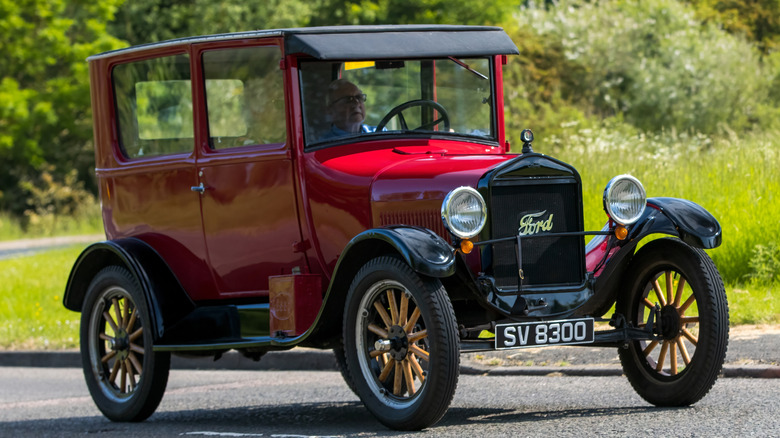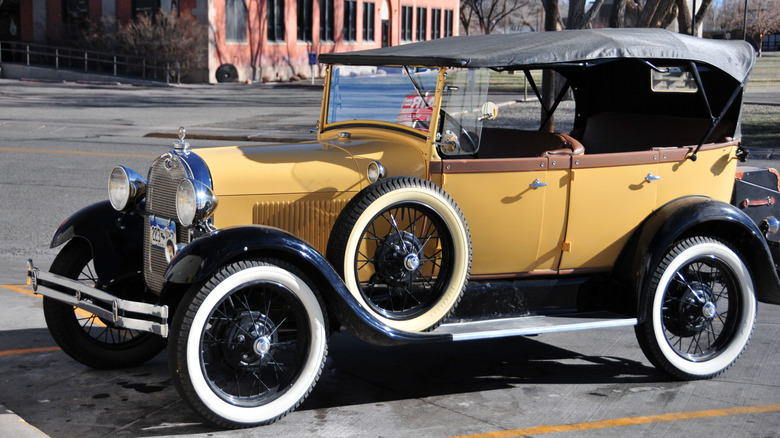How Many Ford Model Ts Were Made And What's One Worth Today?
First released in 1908 by the Ford Motor Company, the Model T is one of the most important vehicles ever made. While it wasn't the first car to be produced on an assembly line, Ford took steps that revolutionized how cars are manufactured to this day. Despite the basic manufacturing technology of the era, the production figure for the model is astounding, with Ford able to build more than 15 million Model T's during its 19-year production run. The best estimate from the Model T community is that there are around 50,000 running examples remaining, and they come up for sale from time to time. Classic.com shows almost 300 Model T sales at an average price of just under $17,000, although a the second one ever built fetched $246,400 at auction in 2022.
During the car's first years, it took about 12.5 hours to assemble one Model T. However, Henry Ford wanted to improve how his company made cars and saw an opportunity through the moving assembly lines that other industries were using. By 1923, Ford had made the necessary improvements and adaptations to the assembly line process, and a Model T could now be assembled in just 90 minutes.This refinement allowed Ford to lower the prices of his cars significantly over time. When it first came out in 1908, the Model T was priced at $850 (about $29,000 today), but by 1924, the Model T could be purchased for just $260 (less than $5,000 in 2025 dollars).
Made fast and sold in the millions
Ford employed more than just refinements to the assembly line to improve the production of its cars. One of these was the use of interchangeable parts. This meant that all parts of the car would fit all Model T's, which added to the factory's efficiency and made the cars easier to repair for owners. Ford also understood the value of its workforce, and reacted well when worker morale and performance declined after the assembly line went into use. With his employees now bored with performing repetitive tasks, Ford announced in 1914 that he was cutting the work day from 9 to 8 hours and would pay $5 a day — about double the industry standard.
A popular misconception about the Model T is that it was only available in black, which was not strictly true. This myth was based on a statement Ford made to that effect, although the Model T was only restricted to black from 1914 to 1925. Through 1913 and in 1926 and 1927, it was available in blue, grey, red, or green.
Also called the "Tin Lizzie," the Model T was one of first cars to sprout multiple body styles from the same platform. It was available in numerous formats: two-door sedan, four-door sedan, touring, runabout, coupe, town, tourister, torpedo, and couplet. Some Model Ts were even converted to tracked snowmobiles.
A lasting legacy for automobiles
The Model T was envisioned as a car for the masses, which meant it was tough, simple to operate, and easy to repair. Its low price meant that more people could afford to buy it, but it was never built cheaply, as the materials and components used in its construction were strong and cost-effective. It remains a desired collectible today, and the fact that so many are still running is a testament to their build quality. The last Model T rolled off the line on May 26, 1927, and was considerably outdated at that time.
Its rivals — including the Chrysler 70 Roadster and the Lasalle 303 — had engines that were three or four times as powerful as the nearly two-decade-old Ford, along with advanced suspensions and transmissions. By today's standards, the 20 to 22-horsepower engine of a 1908 Ford Model T isn't impressive, as a modern air compressor or water pump would have the same power, and the Model T's top speed of 45 mph is lower than some e-bikes or scooters. Despite these rather uninspiring specifications, the Ford Model T is an icon that has secured its place in automotive history because of its impact on motoring and manufacturing.


